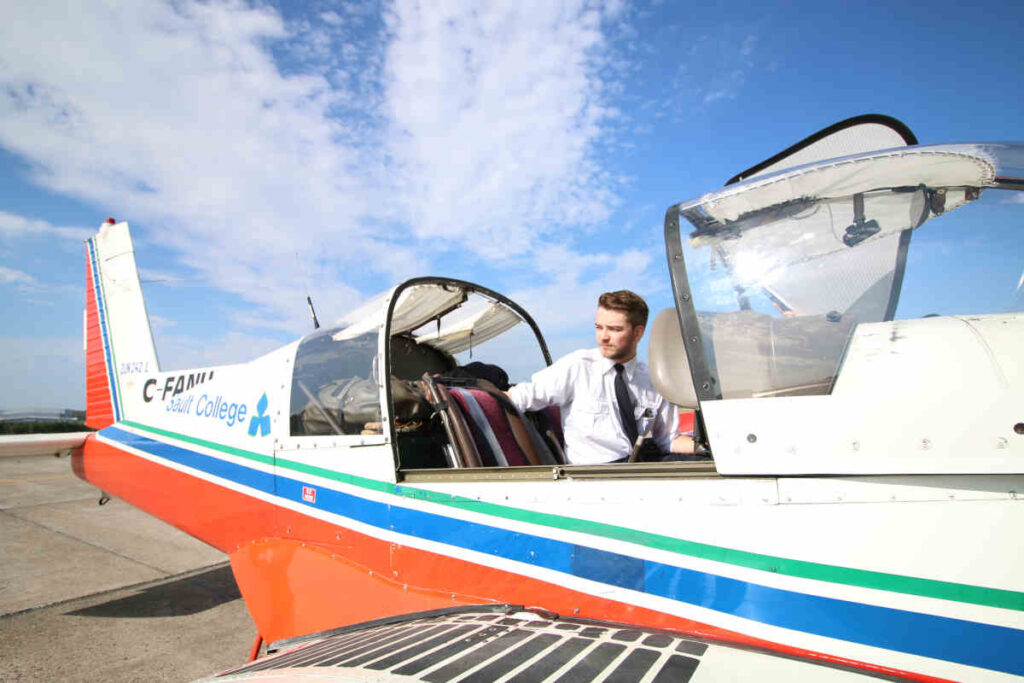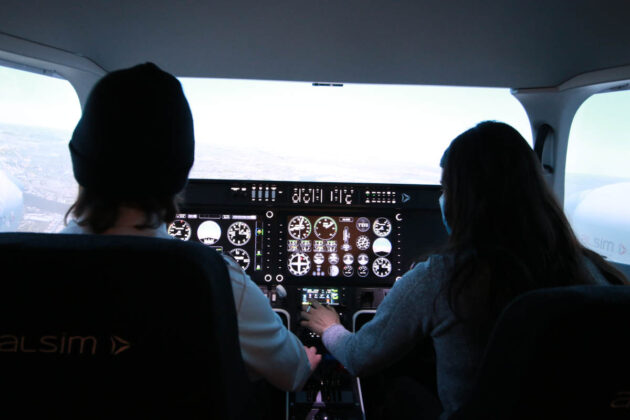
News
Training
Preparing a new generation of pilots
September 18, 2023
Brought to you by by Sault College
 Students in the Sault College Aviation Technology – Flight program are able to train
in controlled and uncontrolled airspace close to the airport, as well as fly across the
border to gain American airspace and airport experience. (Photo: Sault College)
Students in the Sault College Aviation Technology – Flight program are able to train
in controlled and uncontrolled airspace close to the airport, as well as fly across the
border to gain American airspace and airport experience. (Photo: Sault College) As labour shortages ground more flights and squeeze airline schedules, Sault College is ramping up to put a new generation of pilots in the cockpit. The northern Ontario college’s Aviation Technology – Flight program offers a three-year, advanced diploma that prepares students for a career as a commercial pilot, compared with the four-year program offered by many other flight schools. Sault College graduates with success-oriented career training regularly achieve top marks in evaluations with prospective employers.
During COVID-19, Sault College took the opportunity to expand its training fleet and modernize the curriculum to better prepare students for what the post-pandem
ic industry was looking for, especially in the regional air transport sector, which makes up the bulk of flying outside the main cities. The college has always been an innovator in tailoring training to demand by using advanced aircraft from day one, integrating simulator training to prepare students for flight and using data-driven decision making to support a program focused on student success. Regional airline pilots fly at a higher altitude than private or small commercial charter pilots do, and regional operators place a priority on how pilots work together on the flight deck. All are part of the curriculum.
“It is a fully integrated curriculum for a seamless learning experience,” says Greg Farish, the college’s Dean, Aviation. “Students are retaining information better, progressing faster and are quicker to make the transition from ground school to the airplane. This helps there to be fewer issues in the cockpit, which has cut down on repeat training.”
In December 2022, Sault College took delivery of two of the latest versions of the single-engine ZLIN Z 242 L advanced trainer. Designed as an aerobatic aircraft, the Czech-built ZLIN is one of the most rugged and versatile trainers in the field. Students learn to fly in a spacious cockpit, with superior visibility and the latest avionics, including a Garmin G500 glass cockpit. “The ZLIN is a great transition aircraft for new pilots,” Farish said. “The aircraft’s responsiveness to flying is very good, so students get a real feel for what they are doing very early.”

Sault College has always been an innovator in tailoring training to demand by using advanced aircraft from day one, as well as integrating simulator training to prepare students for flight and
using data-driven decision making. (Photo: Sault College)
Sault College has 14 ZLIN trainers in its fleet and is the largest operator of the aircraft in North America. The ZLIN is the “back bone” of flight training, carrying out approximately 87 per cent of training missions. The ‘last mile’ is carried out in the larger, twin-engine Piper Seminole, which students appreciate for its ease of transition from single to multi-engine flying. After the students have completed their commercial pilot licence, the arrival of a third Seminole has allowed the college to increase multi-engine training capacity for the multi-engine and Group 1 Instrument ratings, making them attractive candidates when they graduate.
Before a student can get behind the controls of either the ZLIN or Seminole, however, time is spent in the simulator. In addition to general simulators, Sault College also uses more specialized level 5 simulators, built to replicate the cockpits of the two aircraft in the fleet. “Students are familiar with the airplane cockpit from the beginning,” Farish said. “When they are in that ‘sim’ they are already immersed in the airplane they will be flying.” Students will spend about 10 hours being taught the basics in a simulator before getting into the cockpit.
Sault College did not have an intake of students in fall 2020 due to COVID-19, putting existing students first and ensuring they received the training they needed minimizing disruption by the pandemic. By managing the demand level, the decks are clear and the college has capacity to accept a full intake of approximately 90 students this fall. As a community college, we strive to serve local students, but the bulk of enrolment comes from southern Ontario along with students from all across Canada. With training spots in the Greater Toronto Area disappearing with the planned closure of Buttonville Municipal Airport, Sault College can help provide the pilot training students are looking for.
Sault College’s program offers benefits beyond flight training. Students quickly feel they are part of the community. Students can also benefit from the partnership between Sault College and the Sault Ste. Marie Airport Development Corporation. In March, the airport development corporation launched a scholarship for four first-year aviation students as part of its 25th anniversary. “It only seems a natural fit for the airport to provide financial assistance for new flight training students, not only supporting our tenant family member Sault College, but also assisting in addressing the worldwide pilot shortage,” Terry Bos, chief executive of the Sault Ste. Marie Airport Development Corporation said. The airport handles a combination of commercial flights, Ministry of Natural Resources and Forestry aircraft, with the college responsible for the majority of aircraft movements. Approximately 60,000 at its pre-Covid peak.
In the air, students train in controlled and uncontrolled airspace close to the airport and fly across the border to gain American airspace and airport experience. Cross-country training includes 2.5-hour long flights to Wawa via Chapleau, giving students experience flying up the side of Lake Superior and over open bush. Training flights are also made to southern Ontario to provide hands-on experience with Toronto air traffic control, the busiest in the country.
A shortage of pilots does not mean an easing of standards when it comes to hiring. Competition for a seat in the cockpit remains fierce and Sault College is dedicated to giving students a competitive advantage by knowing what the industry is looking for, especially in the regional airline sector, which is also where the larger airlines go for most of their hires. The college also offers jobs to graduates in the Aviation Technology – Flight program, allowing them to pass on their experiences to a future intake of students.
On the benefits of a three-year over four-year program, Farish says the workload is “high” at the beginning but it pays off, and students are able to launch their careers sooner. “Right from the beginning it is advanced training, which makes the transition into the twins easier because students are more comfortable with the advanced controls. If you have a real interest in aviation and are committed to it, we have a spot for you.”